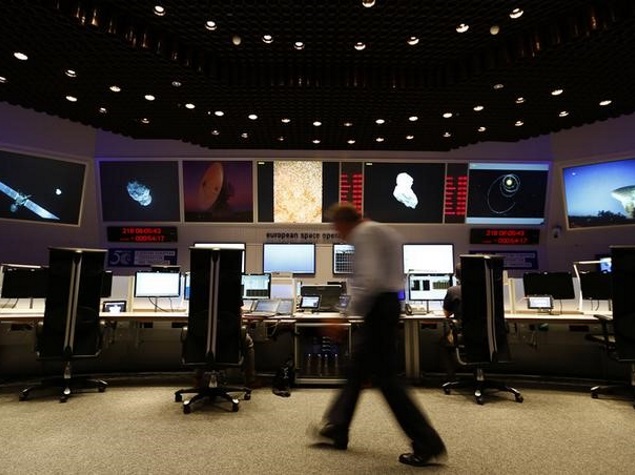- Home
- Science
- Science News
- Moment of Truth in Europe's Ten Year Mission to Explore a Comet
Moment of Truth in Europe's Ten-Year Mission to Explore a Comet

The European Space Agency early on Wednesday gave the final go-ahead for the Rosetta spacecraft, which has been orbiting comet 67P/Churyumov-Gerasimenko since August, to jettison a lander to collect samples from the surface.
They will give insight into how Earth and other planets formed, because comets are remnants of the formation of the 4.6-billion-year-old solar system. Scientists believe they may have brought much of the water in today's oceans.
A problem with the thruster that was due to help stop the lander from bouncing back off the comet's surface means it may rely solely on its harpoons to anchor it to the surface.
"There were various problems with the preparation activities overnight but we have decided to go. Rosetta is lined up for separation," said Paolo Ferri, ESA's head of mission operations.
The team must make sure to release the three-legged lander, named Philae, at exactly the right time and speed because they have no way of controlling it on its seven-hour descent.
Separation of Philae from Rosetta is due to be confirmed on Earth at around 0900 GMT, with news of the landing due at 1600.
Engineers designed the lander not knowing what type of terrain they would find on the comet's surface. Rosetta has been taking pictures of the comet and collecting samples from its atmosphere as it approaches the sun, showing it is not as smooth as initially hoped, making landing tricky.
The surface is also more dusty and porous than expected and the comet gives off gases with a sulphuric, rotten-egg smell.
The probe needs to land somewhere not too dusty or dark, so that light can reach its solar panels and power its instruments once its batteries run out after two and a half days.
If it does manage a smooth touchdown, it will complement studies already under way by Rosetta.
Philae includes experiments to test a molecule's symmetrical construction, or chirality. Amino acids on Earth are 'left-handed,' while DNA and RNA are 'right-handed.' Scientists are curious how the comet's samples compare.
© Thomson Reuters 2014
For the latest tech news and reviews, follow Gadgets 360 on X, Facebook, WhatsApp, Threads and Google News. For the latest videos on gadgets and tech, subscribe to our YouTube channel. If you want to know everything about top influencers, follow our in-house Who'sThat360 on Instagram and YouTube.
Related Stories
- Galaxy S24 Series
- MWC 2024
- Apple Vision Pro
- Oneplus 12
- iPhone 14
- Apple iPhone 15
- OnePlus Nord CE 3 Lite 5G
- iPhone 13
- Xiaomi 14 Pro
- Oppo Find N3
- Tecno Spark Go (2023)
- Realme V30
- Best Phones Under 25000
- Samsung Galaxy S24 Series
- Cryptocurrency
- iQoo 12
- Samsung Galaxy S24 Ultra
- Giottus
- Samsung Galaxy Z Flip 5
- Apple 'Scary Fast'
- Housefull 5
- GoPro Hero 12 Black Review
- Invincible Season 2
- JioGlass
- HD Ready TV
- Laptop Under 50000
- Smartwatch Under 10000
- Latest Mobile Phones
- Compare Phones
- Huawei Pura 70 Pro+
- Huawei Pura 70 Ultra
- Tecno Camon 30 Premier 5G
- Motorola Edge 50 Fusion
- Oppo A1i
- Oppo A1s
- Motorola Edge 50 Ultra
- Leica Leitz Phone 3
- Asus ZenBook Duo 2024 (UX8406)
- Dell Inspiron 14 Plus
- Realme Pad 2 Wi-Fi
- Redmi Pad Pro
- Cult Shock X
- Fire-Boltt Oracle
- Samsung Samsung Neo QLED 8K Smart TV QN800D
- Samsung Neo QLED 4K Smart TV (QN90D)
- Sony PlayStation 5 Slim Digital Edition
- Sony PlayStation 5 Slim
- IFB 2 Ton 3 Star Inverter Split AC (CI2432C323G1)
- Daikin 1 Ton 3 Star Inverter Split AC (FTKL35UV16W+RKL35UV16W)

















